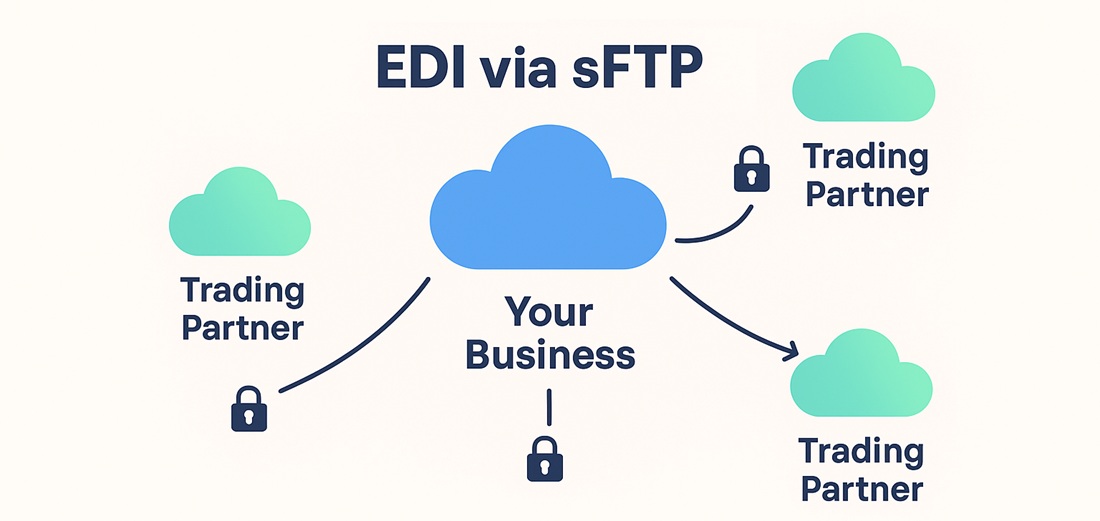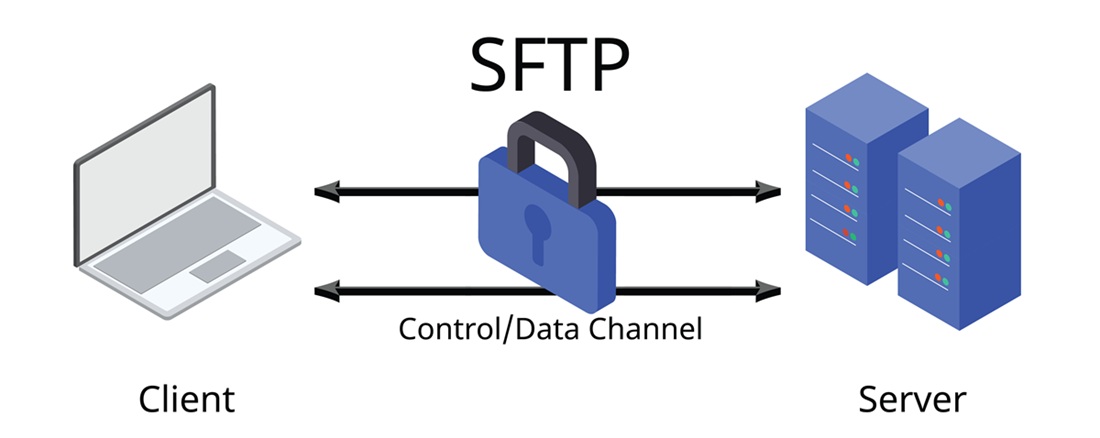When people think of EDI today, they often imagine AS2 connections, API integrations, or fancy cloud-based portals. But quietly running behind the scenes of thousands of supply chains is a much simpler and older method EDI via SFTP. It isn’t flashy, but it’s secure, dependable, and surprisingly efficient for businesses that want an affordable way to exchange documents with their trading partners.
In this blog, we’ll walk through how EDI via SFTP actually works, the kinds of companies that still rely on it, why it continues to stick around even in 2024, and when you might want to use it yourself.
What is sFTP (Secure File Transfer Protocol)?
sFTP is a safe way to move files from one computer or server to another over the internet. Think of it like a locked, protected tunnel that keeps your files secure while they travel.
Unlike old-school FTP which sends data in plain text, sFTP encrypts everything, including your username, password, and the actual files. That means nobody can “peek” at the information while it’s being sent.
Businesses use sFTP to securely upload and download important files such as orders, invoices, or shipping documents without worrying about data being exposed.
What is EDI (Electronic Data Interchange)?
EDI (Electronic Data Interchange) is a way for businesses to swap important documents like purchase orders, invoices, and shipping details directly from one computer system to another without any manual work.
Instead of emailing PDFs or typing data in by hand, EDI allows the information to flow automatically in a standard format both systems understand. This makes communication between trading partners faster, more accurate, and far less messy.
What is EDI via SFTP?
EDI via sFTP is a secure, file-based way for two businesses to exchange electronic documents without using complicated integrations or expensive VANs. Instead of sending data in real time, both parties connect to a shared sFTP server which works like a protected online folder.
Each partner is given their own secure login and access to two folders. One for sending files and another for receiving them. Whenever your system produces an EDI document (such as an order or invoice), it simply drops the file into the outbound folder so your trading partner can grab it. Your trading partner’s system securely downloads it from there. The same thing happens in reverse, when they send you a file, they place it in your “inbound” folder, and your system automatically picks it up and processes it.
sFTP keeps both your files and login information safe by locking them with encryption while they travel online. This level of security paired with its simplicity, low cost, and ability to grow with your business, is what makes EDI over sFTP a popular alternative to more traditional (and expensive) EDI connection methods.
How Does EDI via SFTP Actually Work?
In day-to-day use, EDI via SFTP is actually very simple and predictable. Two trading partners agree on who will host the SFTP server and then exchange the login credentials (typically using SSH keys for security). Once that’s done, a few folders are set up usually one for incoming files, one for outgoing files, and another to archive anything that’s already been processed. From there, documents are automatically dropped into the right folders and picked up on the other side without anyone needing to manually move files around.
Let’s say a retailer sends you an 850 purchase order. They’ll drop the file into the “outbound” folder on their end, which appears as “inbound” on your end. Your EDI system automatically checks that folder, pulls the file, translates it, and sends it into your ERP. When you’re ready to send back an 856 ASN or 810 invoice, you simply drop it into your own outbound folder, and they collect it from there. Everything happens without human intervention. Once it’s set up, it runs in the background like a well-oiled machine.
Why Companies Still Choose EDI via SFTP
For many businesses, simplicity is a major selling point. SFTP doesn’t require certificate exchanges like AS2 or expensive subscription costs like VAN services. As long as you have an SFTP server (or your EDI provider offers one), you can get started quickly and at a relatively low cost. On top of that, SFTP transfers are encrypted, so your files stay secure while in transit. It’s also highly flexible, partners can exchange any document type and can tweak folder structures without shutting everything down.
Because it runs in batch mode (typically checking folders every few minutes), EDI via SFTP works very well for companies that don’t necessarily need real-time responses but still want a “hands-off, automated” way to exchange documents with trading partners.

Who Typically Uses EDI via SFTP?
You’ll often find EDI via SFTP being used by manufacturers, wholesalers, distributors, and 3PLs, especially those working with multiple trading partners that don’t all support AS2 or real-time API integrations. It’s also very common between internal divisions of large companies (for example, transferring data between various plants or warehouses). For many growing e-commerce brands, EDI via SFTP is a practical “middle ground,” giving them a reliable integration option without forcing them to invest in expensive infrastructure right away.
Best Practices for Smooth SFTP-Based EDI Integration
To make sure your EDI via SFTP setup runs efficiently and securely, it’s important to follow a few ground rules. First, always use SSH key–based authentication instead of basic passwords. Second, give each trading partner their own folders and access rights to avoid accidental cross-access or data leaks. Third, automate both the drop-off and pickup of files with scheduled scripts or EDI software. This keeps humans out of the loop and eliminates day-to-day headaches.
Because SFTP connections don’t send delivery receipts like AS2 does, it’s also smart to have alerts and daily monitoring in place so you’re notified if a file doesn’t arrive or fails to process. Lastly, don’t forget to move completed files to an archive folder. It keeps your active folders clean and creates a reliable audit trail in case you need to look back later.
Limitations to Be Aware Of
Like anything in tech, EDI via SFTP isn’t perfect. Its biggest downside is that it doesn’t work in real time. Since files are exchanged in timed batches, you won’t get instant confirmations or live tracking like you would with AS2 or API integrations. That can be a problem if you’re serving high-volume retailers or trading partners who expect acknowledgments within seconds. As you grow and onboard more partners, things can get a little messy too. Each connection may need a different SFTP folder, firewall rule, or script.
That said, for a lot of companies the simplicity, flexibility, and lower cost of SFTP still make it a very attractive option especially when speed isn’t a deal breaker.
SFTP vs AS2 vs VAN vs API: Choosing the Right Fit
Wondering if EDI via SFTP is the right fit for your business? It really depends on what your trading partners expect, how much data you’re moving, and how much IT bandwidth you have. If you're okay with sending documents in batches and want something secure, automated, and low-maintenance then SFTP can work beautifully.
On the other hand, if you need real-time document exchange with big retailers who expect immediate acknowledgments, AS2 might be a better option. And if you want to outsource everything without touching the technical setup at all, a VAN (Value-Added Network) can do that though it usually comes with higher monthly or per-document charges.
API integrations are best for companies that want instant communication directly between their applications but they usually require significantly more development work.
Because of that, many businesses use a hybrid approach SFTP with some partners and AS2 or API-based EDI with others.
Why Managed Providers Still Recommend EDI via SFTP
Handling EDI via SFTP internally may sound easy at first, but managing multiple maps, folders, and error-handling workflows can become time-consuming. That’s where managed EDI providers help the most. Providers like Infocon Systems take care of the entire process: onboarding trading partners, building your maps, managing SFTP folders, translating files, integrating with your ERP, handling 997 acknowledgments, even alerting you if something goes wrong. That way, your IT team doesn’t have to monitor uploads, manage scripts, or chase down missing files. Everything is automated, secure, and scalable and if you want to upgrade later to AS2 or API, you can do it without starting from scratch.
Final Thoughts: Is EDI via SFTP Still Worth Considering?
Even in today’s world of ultra-modern, cloud-native integrations, there’s still a strong case for EDI via SFTP. It’s secure, stable, and cost-effective, especially for supply chain partners that don’t need responses in real time. If you’re exchanging documents like 850s, 810s, or 856s and want an easy way to stay compliant without locking yourself into expensive infrastructure, EDI via SFTP remains a smart, proven choice. Just make sure you follow best practices or work with a provider who can manage the heavy lifting on your behalf.
To learn more about how Infocon Systems can take care of your EDI needs, please don’t hesitate to give us a call at +1 888-339-0722 or email sales@infoconn.com. We’d love to hear from you.




